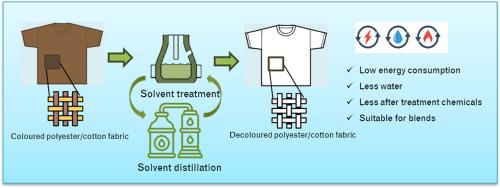溶剂辅助方法的绿色脱色纺织品和时装废料
IF 6.5
Q2 ENGINEERING, ENVIRONMENTAL
引用次数: 0
摘要
人们对消费前纺织品废料的脱色越来越感兴趣,其中包括具有不同成分的制造废料。本研究考察了二甲基亚砜(DMSO)作为溶剂去除涤纶和棉织物上染料分子的有效性。我们的研究结果表明,经过多次处理循环后,DMSO对100% PET纺织废料的脱色效果显著,而对棉花的影响不太明显,强调了染料纤维粘合和DMSO对纤维的行为的影响。然而,二甲基亚砜可以有效地用作棉花的预处理,甚至可以消除单独漂白步骤的需要。在混纺纺织品中使用DMSO的一个显著优点是它能够降低整体颜色强度,而不需要分离混纺成分。这种方法为纺织废料的脱色提供了一种可持续的解决方案,强调在纺织废料回收过程中减少处理步骤、减少化学品使用和降低能耗。本文章由计算机程序翻译,如有差异,请以英文原文为准。

Solvent assisted approach for greener decoloration of textile and fashion waste
There is a growing interest in the decolorization of pre-consumer textile waste, which includes manufacturing scraps with diverse compositions. This study investigates the effectiveness of dimethyl sulfoxide (DMSO) as a solvent for removing dye molecules from both polyester and cotton fabrics. Our findings demonstrate that DMSO significantly decolorizes 100 % PET textile waste after multiple treatment cycles, while its impact on cotton is less pronounced, underscoring the influence of dye-fiber bonding and the behaviour of DMSO on fiber. Nevertheless, DMSO can be effectively used as a pre-treatment on cotton and may even eliminate the need for a separate bleaching step. A notable advantage of using DMSO for blended textiles is its ability to reduce overall color intensity without the need to separate the blend components. This approach presents a sustainable solution for the decoloration of textile waste, emphasizing fewer processing steps, reduced chemical usage, and lower energy consumption during recycling of textile waste.
求助全文
通过发布文献求助,成功后即可免费获取论文全文。
去求助
来源期刊

Cleaner Engineering and Technology
Engineering-Engineering (miscellaneous)
CiteScore
9.80
自引率
0.00%
发文量
218
审稿时长
21 weeks
 求助内容:
求助内容: 应助结果提醒方式:
应助结果提醒方式:


